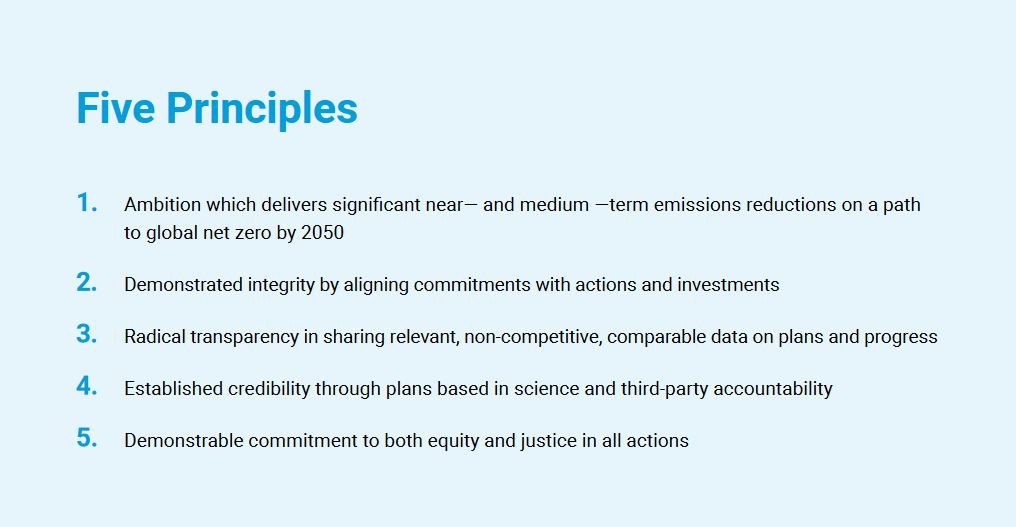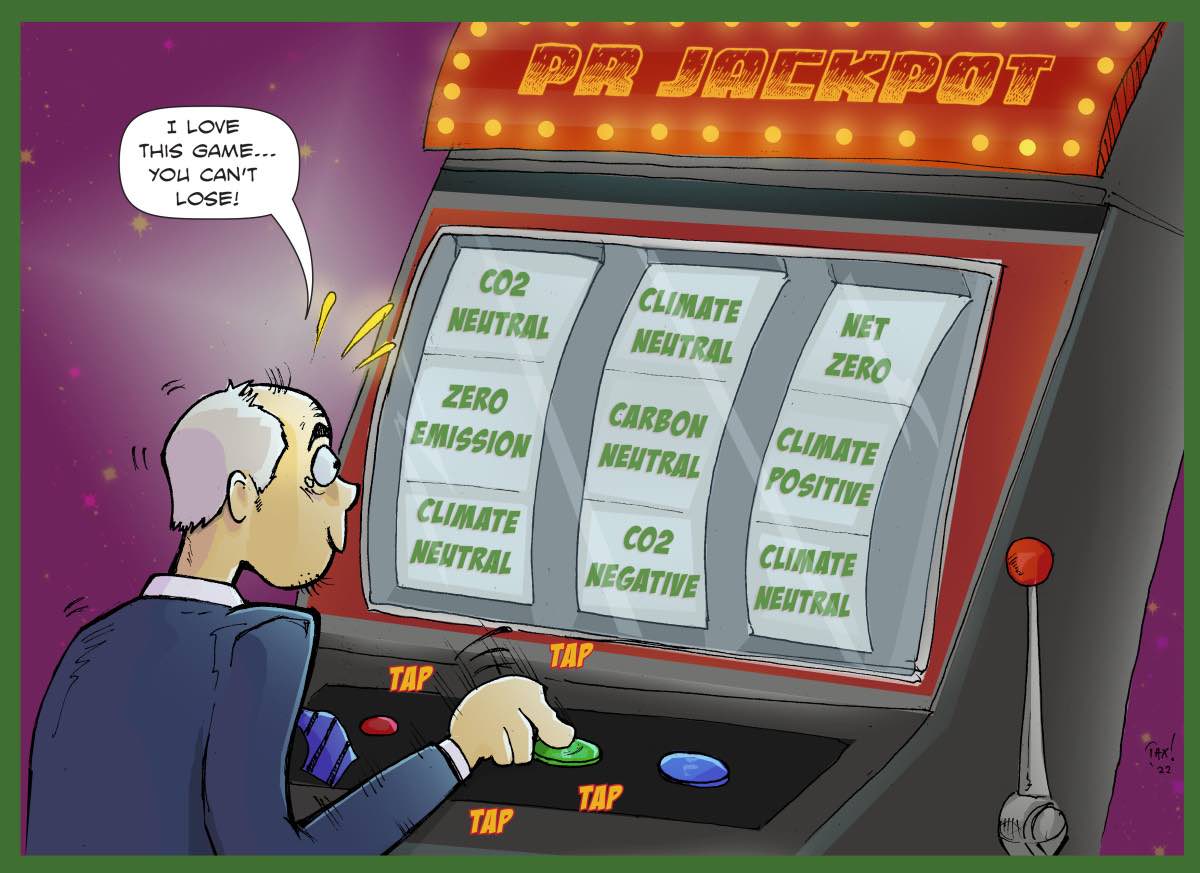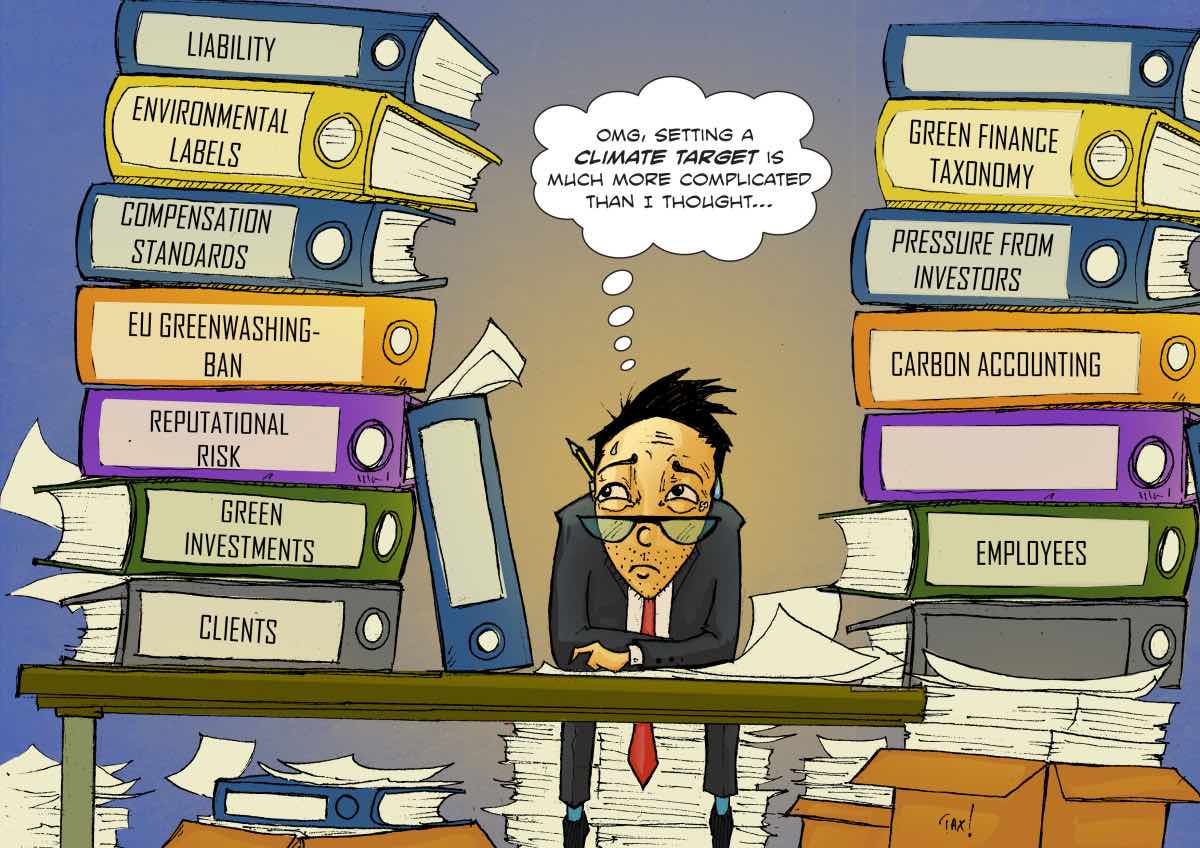Net zero targets are spreading like wildfire through the corporate world.
Faced with increasing pressure to act on climate, one company after another is announcing plans to eliminate its carbon footprint. The big question is: Do these corporate net zero pledges prove that companies have finally woken up to their urgent responsibility to help contain the rise of global temperatures?
On closer inspection, countless ambitious-sounding pledges ring hollow. Many commitments are little more than vague declarations of intent. Others hide huge chunks of a company’s CO2 pollution, or rely on dubious promises to compensate continued emissions, while lacking efforts to reduce fossil fuel use.
Concern about unsubstantiated net zero claims has become widespread as a result. “We must have zero tolerance for net-zero greenwashing,” said UN Secretary-General Antonio Guterres at the Climate Conference (COP27) at Sharm el-Sheikh during the presentation of an expert report on net zero targets.
But for the uninitiated, it’s hard to tell greenwashing from serious commitment because scrutinising company climate pledges is complicated. For example, net zero target years trumpeted in advertising are meaningless if they only cover a small part of a company’s total emissions, or if they are not backed up by a serious strategy to cut greenhouse gas output.
Net zero targets only advance the fight against climate change if they fulfil a whole range of conditions, and only a complete assessment will reveal whether they do. Also, it’s important to keep in mind that a company can be ambitious on climate action without having a net zero target at all. A convincing plan for deep emission cuts in the near term is much more laudable than a distant net zero target that lacks a credible strategy for reaching it.
To make deciphering net zero targets as easy as possible, Clean Energy Wire has compiled a list of seven key criteria, based on the method used by the NewClimate Institute in their Corporate Climate Responsibility Monitor and other publications. Only if the answer to all of the seven following questions is “yes” can a net zero target be called truly robust:
- Does the company publish complete data on its emissions?
- Does the company’s net zero target cover all of its emissions?
- Does the company have concrete plans to quickly reduce its own emissions, without relying on carbon offsets?
- Does the company have interim targets which show it intends to act fast?
- Is the company’s net zero target in line with the Paris Climate Agreement?
- Does the company have a plan to exit oil, coal, and fossil gas?
- Does the company promote renewables in its energy procurement?
The questions cover three general topics that must be dealt with before a verdict on a net zero pledge can be reached: The disclosure and coverage of emissions (questions 1-2); emission reductions and stepping stones (questions 3-5); and actions to achieve the targets (questions 6-7).
All seven criteria include tips, tricks and examples from the NewClimate Institute‘s Corporate Climate Responsibility Monitor or other publications.
1. Does the company publish complete data on its emissions?
Companies should present complete and transparent data on their entire greenhouse gas emissions every year, including those stemming from their value chains and the use of their products or services.
Before a company can set a credible net zero target, it must have a detailed overview of all the emissions it causes. This not only entails accounting for the greenhouse gases it emits directly, but also for the emissions it causes indirectly – for example by using electricity, raw materials, transport, and during the use and disposal of its products and services.
The categories of “scope 1, 2 and 3” emissions are commonly used to describe these different types of emissions. Scope 1 emissions are the direct greenhouse gas emissions from sources that are owned or controlled by a company. Scope 2 refers to indirect emissions from using electricity, heating and cooling in a company’s operations. Scope 3 emissions occur as a consequence of a company’s activities, but are not controlled directly by the company.
They arise in a company’s value chain – for example during the extraction of raw materials, the production of packaging, product transport, and from the use of the company’s products or services, or investment portfolios. Scope 3 emissions are the most difficult to track, but they often dwarf a company’s direct emissions. In the extreme case of Volkswagen, Scope 3 emissions represent 98 percent of the group’s total – mainly through use of their cars. [This factsheet explains the basic terminology of company climate claims.]
Tips & tricks, examples
- Carefully examine the language of scope coverage, including footnotes. This often reveals major loopholes in emission coverage – and consequently the net-zero targets. Sometimes when a company says that their disclosure includes “all xyz”, consider what is excluded from xyz rather than interpreting this at face value as a confirmation of comprehensiveness.
- Check if disclosure is consistent between documents. Some companies achieve A-ratings for transparency from the Carbon Disclosure Project (CDP) by disclosing all emissions in detail to CDP, while then disclosing a different and much more limited set of emissions in public reports. Information disclosed to CDP is not accessible without registration, technical knowledge and in some cases a paywall.
- Check if scope 3 emissions are really complete. Some companies include one category of scope 3 emissions in their reporting (e.g., business travel) to make it look like they have included scope 3 emissions, although in reality this category only accounts for maybe 1% of their scope 3 emissions, while the use of products and the supply chain are much more important. If companies do not set out emissions explicitly for all 15 scope 3 emission categories, be suspicious.
Examples from the NewClimate Institute’s Corporate Climate Responsibility Monitor 2022 & Milieudefensie study:
- Around 97% of Brazilian meat processing company JBS’s emissions are caused by the production of meat on farms. JBS’s emission disclosure and targets cover meat production on “all JBS feedlots and farms.” What they do not point out is that there are very few JBS feedlots and farms, because almost all of their meat comes from a network of partner farms. Accordingly, their disclosure and target only cover less than 3% of their emission footprint.
- French retailer Carrefour reports that its emissions disclosure and target cover “all integrated stores in all nine integrated countries.” While this sounds like confirmation of comprehensiveness, it actually accounts for less than 12% of Carrefour stores in France and less than 20% of Carrefour stores worldwide. All activities in non-integrated stores, and in the other 21 countries that Carrefour operates in, are excluded.
- Swiss pharmaceutical maker Novartis appears to report on scope 1, 2 and 3 emissions in its public report (Environmental Sustainability Strategy), and claims a CDP A-rating for transparency. But for scope 3, it includes only business travel which accounts for only 0.3% of the scope 3 emissions in their CDP disclosure, which is not easily accessible. Overall, this means that their public reporting of emissions includes only 20% of the emissions they report elsewhere.
Where do I find more in-depth guidance?
- Section 1 of the methodology for the Corporate Climate Responsibility Monitor 2022

2. Does the company’s net zero target cover all of its emissions?
Companies should clearly state that their net zero target encompasses their entire emissions, including full value chains and end-use of products and services.
A net zero target is only meaningful if it covers all of a company’s emissions. Many businesses omit scope 3 emissions in their net zero target, even though these often constitute the lion’s share of their climate footprint. For example, a fossil fuel producer might say it aims to reach net zero emissions for the production and supply of oil, gas and coal.
This would not include the – massively larger – emissions its products cause when burned in cars, factories, and power stations across the world. The UN expert group on net zero pledges is also very clear on this point. It says a net zero target must include end-use by covering “all scope emissions and all operations along its value chain in all jurisdictions […] Where data is missing for scope 3 emissions, businesses should explain how they are working to get the data or what estimates they are using.”
Tips & tricks, examples
- Take a very careful look at how a company phrases its net zero target, especially what scope emissions are covered, including footnotes (as for emissions disclosure above).
- Ambitious-sounding targets that only cover scope 1 and 2 emissions can simply be greenwashing a carbon-intensive industry if the main issue lies in the emissions-intensive nature of the product. Several oil companies and Norwegian fertiliser maker Yara are good examples for companies with plans to green the production of things that are inherently incompatible with climate targets.
Where do I find more in-depth guidance?
Section 2.1 of the methodology for the Corporate Climate Responsibility Monitor 2022

3. Does the company have concrete plans to quickly reduce its own emissions without relying on offsetting?
Companies should have a specific greenhouse gas emissions reduction target alongside its net-zero target which does not rely on CO2 removals or offsetting.
Setting a net zero target requires a company to act on its own emissions, instead of leaving the heavy lifting to others via compensation schemes. Reaching the objectives of the Paris Agreement – such as the goal to limit global temperature increase to 1.5°C – means that total CO2 emissions have to be reduced by more than 90 percent by 2050 (compared to 2010 levels), the IPCC said.
Companies have to do their part and rapidly reduce their own emissions, without relying on carbon offsets. Several institutions such as the Science Based Targets initiative and the NewClimate Institute say companies must reduce their emissions by at least 90 percent by the target year below 2019 levels to justify the use of a net-zero label.
The UN expert group also warns that too many firms “are currently engaging in a voluntary [carbon offset] market where low prices and a lack of clear guidelines risk delaying the urgent near-term emission reductions needed.” To avoid the troubles related to many carbon offsets, firms can finance climate action elsewhere on the planet, but without claiming that these neutralise their own emissions (so-called climate contributions).
If a company’s pledges rely on emitting and subsequently removing CO2 from the atmosphere, then these removals must be permanent. If a company relies on biological carbon storage such as planting trees for their net zero target, they create the risk that forest fires, land disturbances, and other developments cause the CO2 to be re-emitted – thus, these removals cannot be considered permanent.
Tips & tricks, examples
Watch out for misleading base year practices.
- British pharmaceutical maker GlaxoSmithKline’s commitment to reduce scope 3 emissions by 16% by 2030 from a 2017 base year translates to no significant further emission reduction compared to 2019 levels, when the target was set.
- US pharma company CVS Health has a net-zero target that includes a commitment to reduce 2019 emissions by at least 90%, but their emissions inventory for 2019 shows emissions that are around double that of the years before or after.
If a company uses carbon removals, carefully check whether they classify as permanent
- Most companies are pursuing removals with biological storage. Some report measures to “improve the risk of non-permanence,” but these are often not credible. They are based on closely monitoring for the re-release of carbon into the atmosphere and promise to take action to compensate for any forestry stock changes caused by forest fire, for example. This can only work in practice if there was a guarantee that the company and the crediting standard keep their promise for at least 100 years, which is nigh impossible.
- “Insetting”: some companies (IKEA, Nestlé) are trying to establish the term “insetting”, a concept they sell as “removals within the value chain”. This is a highly misleading and even less-regulated version of offsetting which itself is a fundamentally flawed approach.
Where do I find more in-depth guidance?
Sections 2.2 and 4.1 of the methodology for the Corporate Climate Responsibility Monitor 2022

4. Does the company have interim targets which show it intends to act fast?
Companies should make clear that their net zero pledges are not just long-term visions, but that they start to act now. Interim targets which require immediate action to sharply reduce emissions in the short and medium term in line with the Paris Climate Agreement are necessary to make their pledges credible.
Companies must not delay the start of emission reductions to the far future to reach a net zero target. If they do not start out with ambitious and rapid efforts to reduce their climate impact, they are responsible for higher cumulative emissions in the long term, and also increase uncertainty surrounding their climate action. “A net zero pledge must contain stepping stone targets for every five years,” says the UN expert group, adding that a company with a net zero target “needs to start fast and not delay action to the last minute.” Interim targets should only refer to cutting the company’s own emissions, without relying on compensation. The UN group stressed that carbon credits “cannot be counted [toward] interim emissions reductions required by its net zero pathway.”
Tips & tricks, examples
- Long-term targets can simply act as a delay and distraction mechanism. It is important to check whether (a) interim targets exists, (b) they cover the same emissions scopes, and (c) the company explains how they align with its long-term vision.
- Medium-term targets should require immediate action and align with 1.5°C-compatible decarbonisation milestones for specific sectors.
Examples:
- Many companies set out long-term visions for 2040 or 2050, but don’t specify interim targets.
- British pharma company GlaxoSmithKline’s targets for 2030 are based largely on the implementation of a single measure (changing technology for inhalers); their pathway shows that the 2030 target (even though relatively near-term) does not require short-term action, since the measures are foreseen to be implemented in 2028 and 2029, just in time for the target achievement in 2030. In the meantime, the implementation of available measures is delayed.
Where do I find more in-depth guidance?
Section 2.3 of the methodology for the Corporate Climate Responsibility Monitor 2022

5. Does the company have a net zero target in line with the Paris Climate Agreement?
Companies should show in a transparent and verifiable manner whether and why their net zero target and any interim targets are compatible with the Paris Climate Agreement. That means the target must be in line with 1.5°C emission pathways for the particular sectors the companies operate in.
A well-defined net zero target does not automatically align with 1.5°C emission pathways for a particular sector. For example: A 2050 net zero target for a European carmaker is not compatible with the Paris Agreement, because this sector has to be decarbonised much sooner to be in line with the 1.5°C goal.
While this point can be difficult and time-consuming to investigate – due to the different standards and evaluations out there – it is a crucial step in assessing company climate targets. In the words of the UN high level group, a company’s net zero pledge must reflect its “fair share of the needed global climate mitigation,” and it must also align or exceed national targets.
Tips & tricks, examples
- Companies often claim that a single verification by the Science Based Target initiative (SBTi) or another standard is fully sufficient to claim Paris Agreement compatibility for its entire business operations. Sometimes these verifications even cover just single emission sources. The claim of 1.5°C Paris Agreement compatibility for net zero target and their interim target should require a broader justification.
- Different standards and evaluations can be compared to get a more comprehensive overview of how a given target compares to global and sector-specific milestones, for example as defined by the Transition Pathway Initiative, the Climate Action Tracker, the State of Climate Action Report, SBTi, the UNFCCC Race to Zero Breakthroughs, and/or the IEA Road to Net Zero 2050 milestones.
- Companies often falsely imply that the verification of a specific target by one single organisation as 1.5°C/or 2°C compatible implies its entire operations and specific reduction measures can be seen as 1.5°C/or 2°C compatible.
Examples:
- There are several carmakers whose emission reduction targets only have a low integrity (see Volkswagen and BMW in CCRM2022) or medium integrity (Stellantis in Milieudefensie analysis), according to the NewClimate Institute.
- Nestlé says that “Information on our approach to climate change can be found in our Nestlé Net Zero Climate Roadmap released in late 2020. This document has been validated by the Science Based Targets initiative (SBTi) and the work that went into it is rigorous and extensive.” The company thus implies that its entire roadmap has been validated by SBTi. But firstly, SBTi does not validate any measures or plans to achieve targets as included in the roadmap. Secondly, as of 15.11.2022, Nestlé has only committed to SBTi but its 2050 net zero target has not been verified by SBTi, while only its 2030 targets (not measures) have been verified.
Where do I find more in-depth guidance?
Section 2.2 and Section 2.3 of the methodology for the Corporate Climate Responsibility Monitor 2022
6. Does the company have a plan to exit oil, coal and gas?
Companies should have a plan to phase out fossil fuels and emission-intensive products.
A net zero target requires that firms quickly end the use of oil, coal, and gas, as well as emission-intensive products. Many companies emphasise that they heavily invest in clean technologies. However, these investments can only be considered as significant emission reduction measures if the main sources of emissions are phased out at the same time.
For example, oil and gas majors might advertise that they are building wind and solar parks, while at the same time continuing their fossil business. Likewise, simply selling emission-intensive fossil assets to subcontractors doesn’t help the climate. The UN expert group also warned that net zero plans must not support new fossil fuel investments, but instead “decommission and cancel existing assets.”
Tips & tricks, examples
- Some companies with emission-intensive business operations are simply shifting emissions off their accounts. Targets covering specific emission scopes can be highly misleading if the company tweaks its business model to let emissions happen elsewhere. For example:
- For electricity generation companies, scope 1 emissions typically account for a lion’s share. Some of those companies set deep decarbonisation targets for scope 1, while transitioning fully or partially from a generation to a retail company. By selling their generation facilities to other (sometimes spin-off) companies, and purchasing the electricity from them, the company appears to make huge emission reductions while in reality the emissions are just shifted from scope 1 to scope 3.
- Logistics companies might also focus on their scope 1 and scope 2 emissions from delivery vehicles. This allows them to achieve dramatic reductions, by fully or partially subcontracting delivery to other companies, which is already common practice in the sector.
Examples:
- German utility E.ON is an example of a company that transitioned nearly fully from a generation to a retail company, and now partly omits scope 3 emissions from energy sales
- Reductions in Italian utility Enel’s scope 1 emissions are also accompanied by an increase of external electricity purchases, and therefore a shift towards scope 3 emissions. There is no clear phase out plan for gas.

7. Does the company promote renewables in its energy procurement?
Companies should use its energy procurement to boost the roll-out of renewables, and be transparent about it.
It matters a great deal for emissions where and how a company sources its energy. Businesses should not only ensure that they use the highest possible share of renewable sources, but also maximise their climate impact while doing so. Simply buying renewable power on the wholesale market does not necessarily reduce total emissions, because it doesn’t directly affect a country’s overall power mix – it simply means there is less green power left for other users.
Ideally, a company installs its own renewable power generation – this is the best guarantee for emissions reductions. In a second-best, its procurement incentivises the instalment of new and additional renewables capacity – projects which would not have happened without the company’s financial support.
Tips & tricks, examples
- Some companies purchase electricity directly from renewable power operators using power purchase agreements, which are high-quality constructs in principle. But if the companies don’t take the associated renewable energy certificates, they allow the renewable plant operator to sell those to other customers, leading to double counting the renewable energy.
Examples:
- Google is particularly transparent and innovative with addressing this problem. In 2020, it set the target to achieve
24/7 carbon-free energy by 2030, meaning that it will ensure its consumption is matched by locally produced
renewable energy, matched on an hourly basis. This good practice approach has subsequently been adopted
by other companies. - Accenture appears to procure energy from PPAs, but without the associated renewable energy certificates.
Where do I find more in-depth guidance?
Section 3.2 of the methodology for the Corporate Climate Responsibility Monitor 2022
Originally published on Clean Energy Wire. Reproduced with permission.
This factsheet is one part of the CLEW focus on company climate claims.
This dossier lists our existing publications and future content plans, and our upcoming events are here.
This blog explains why we decided to launch the project.











